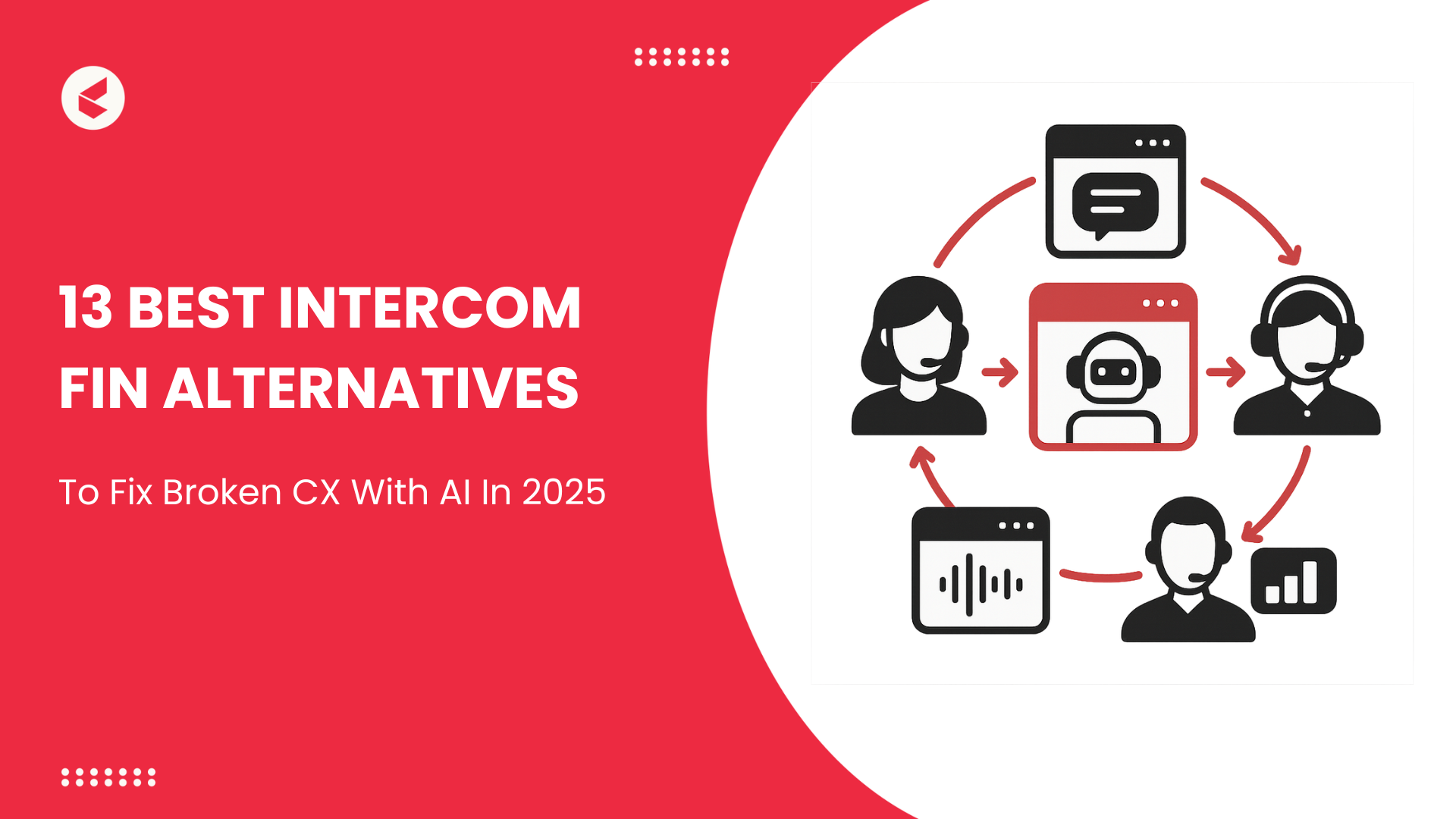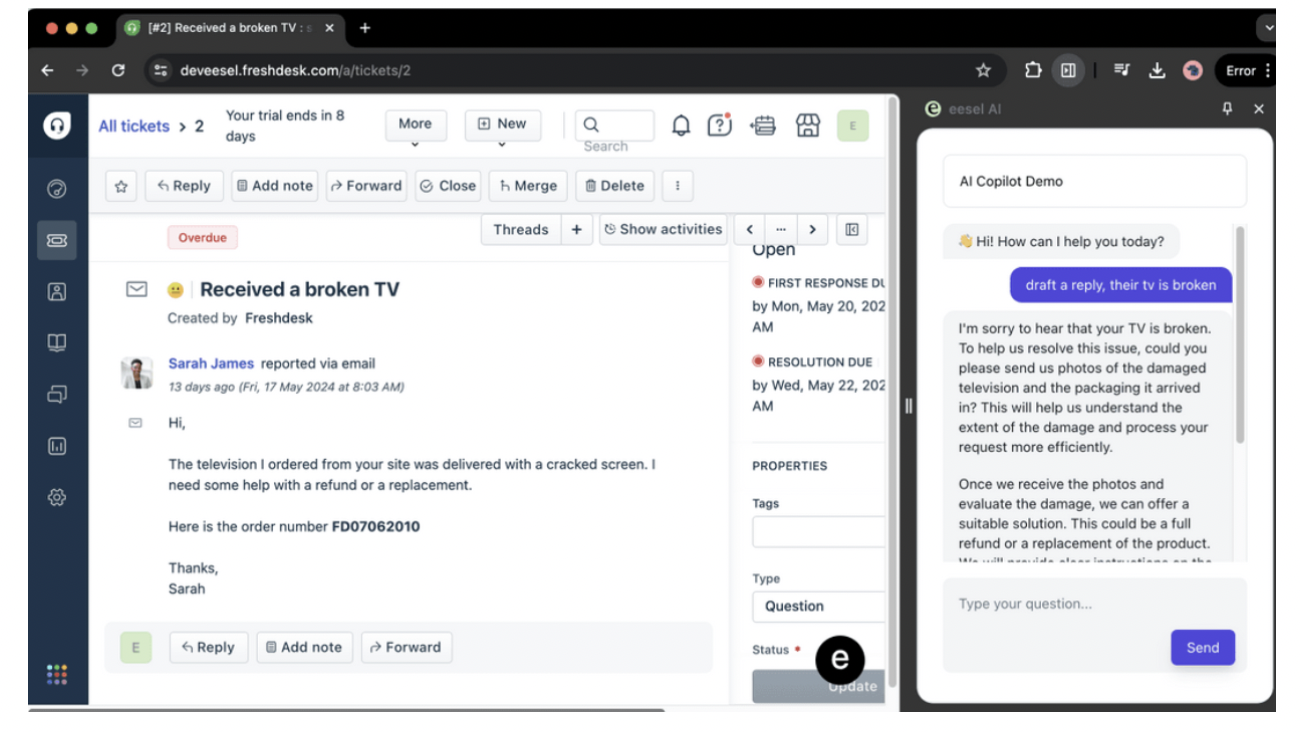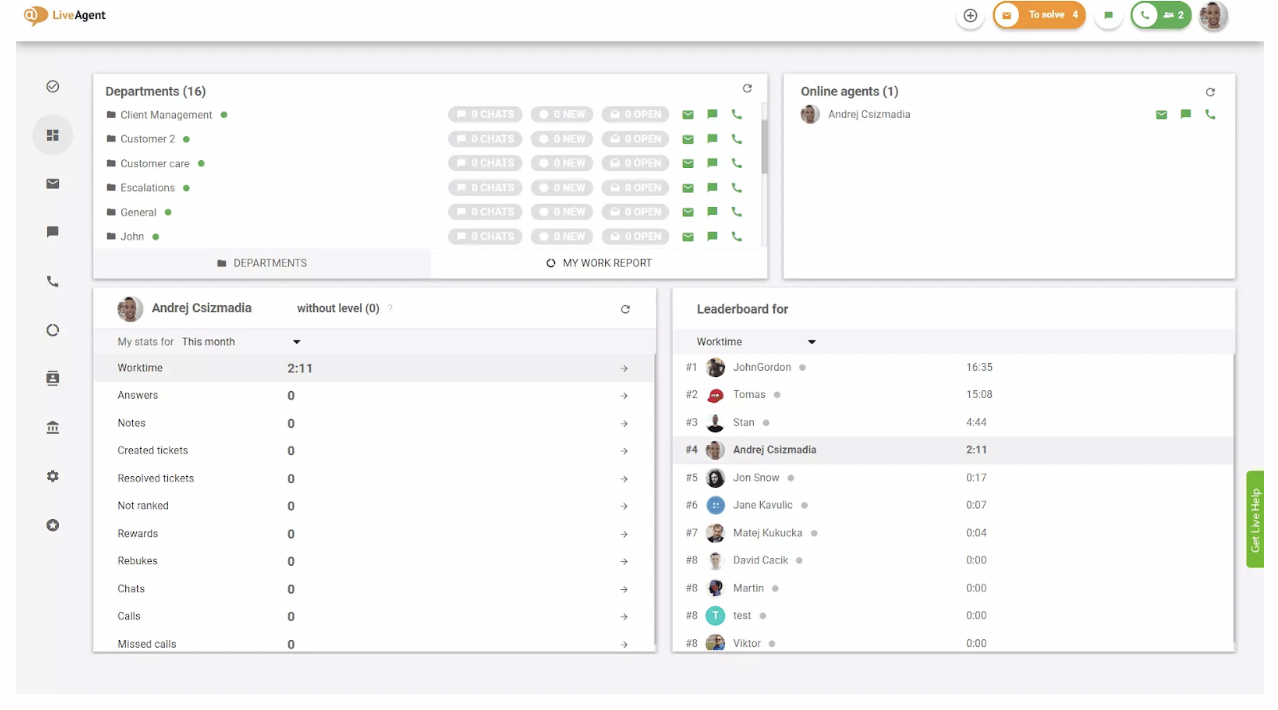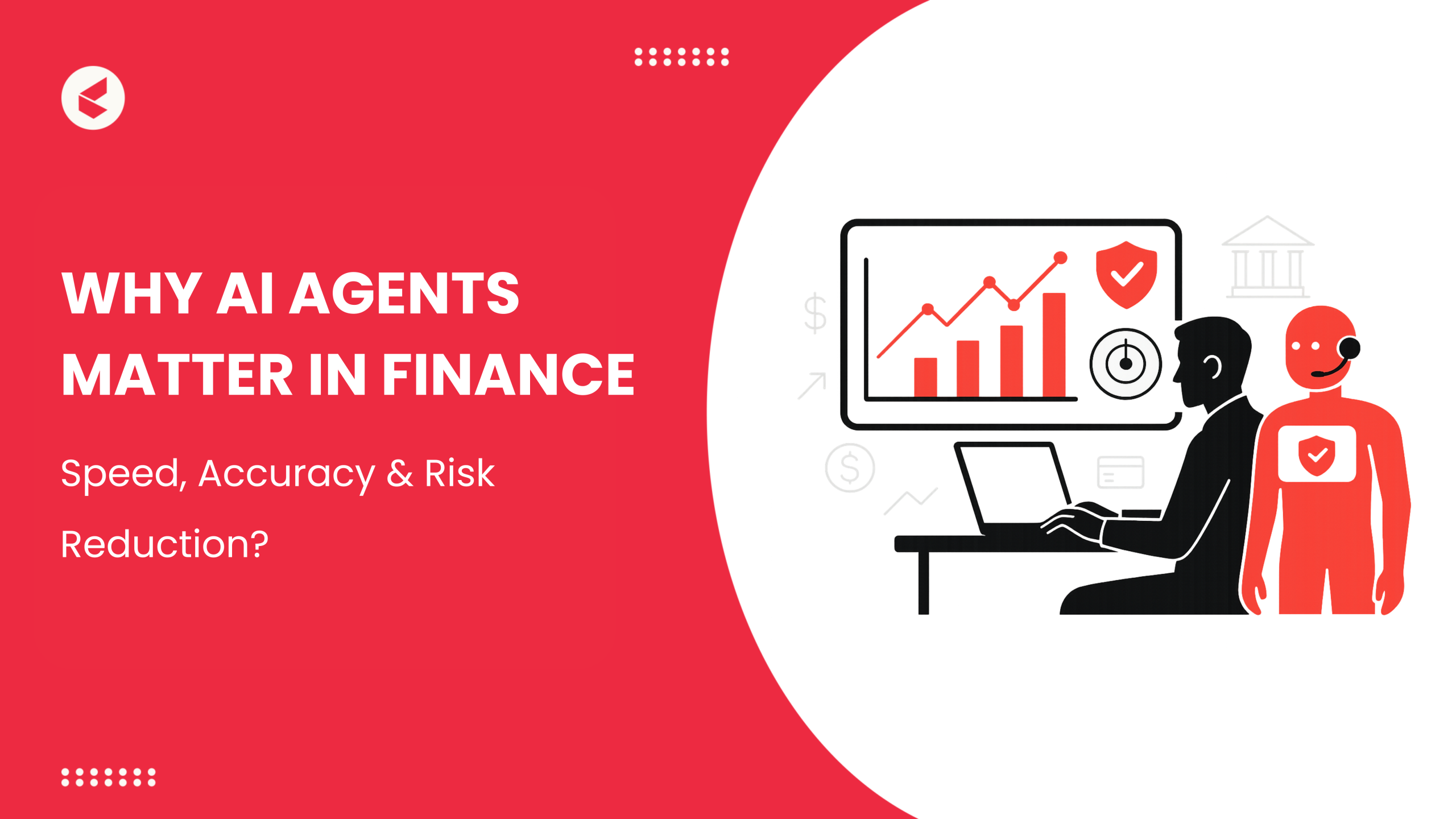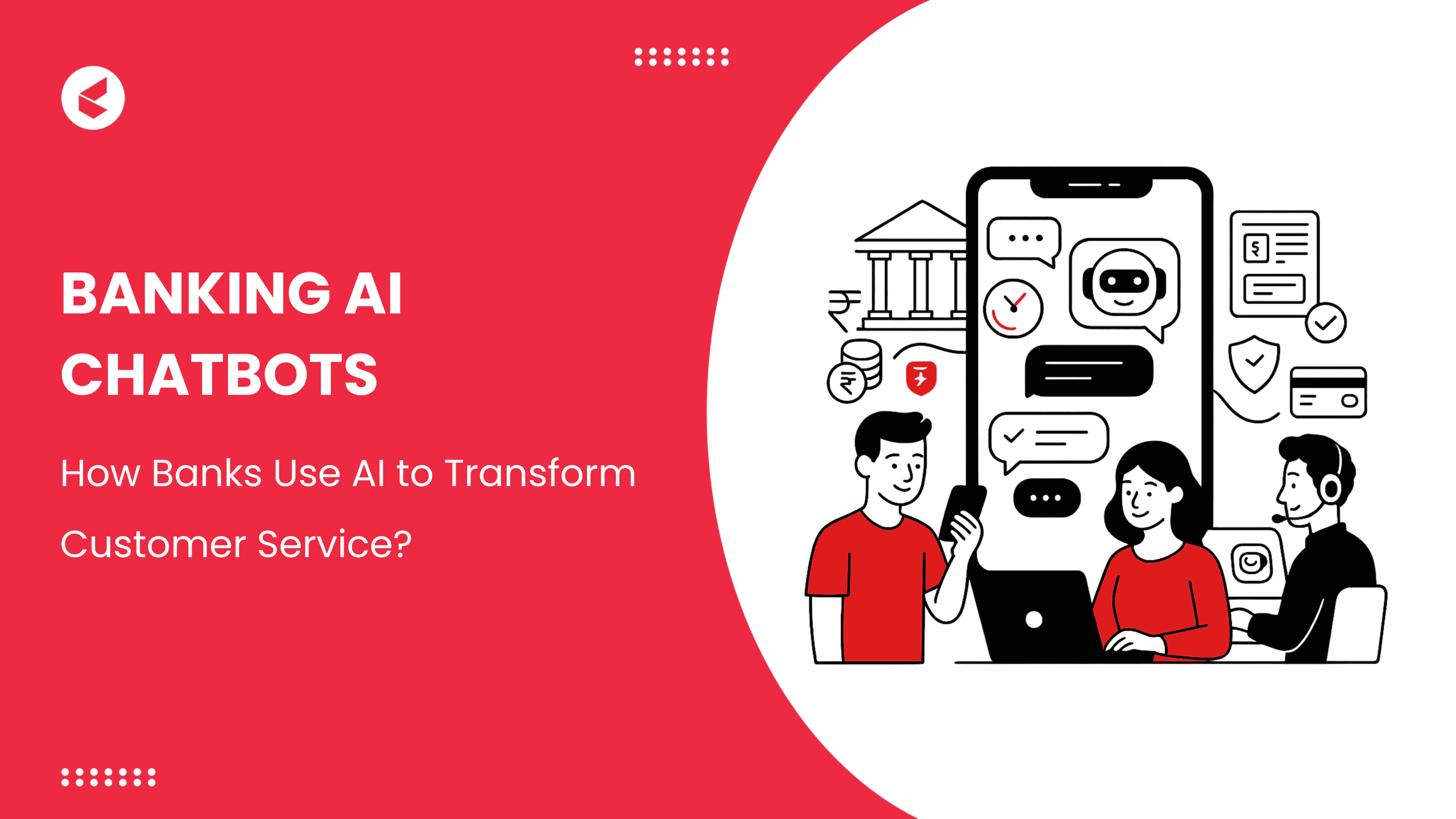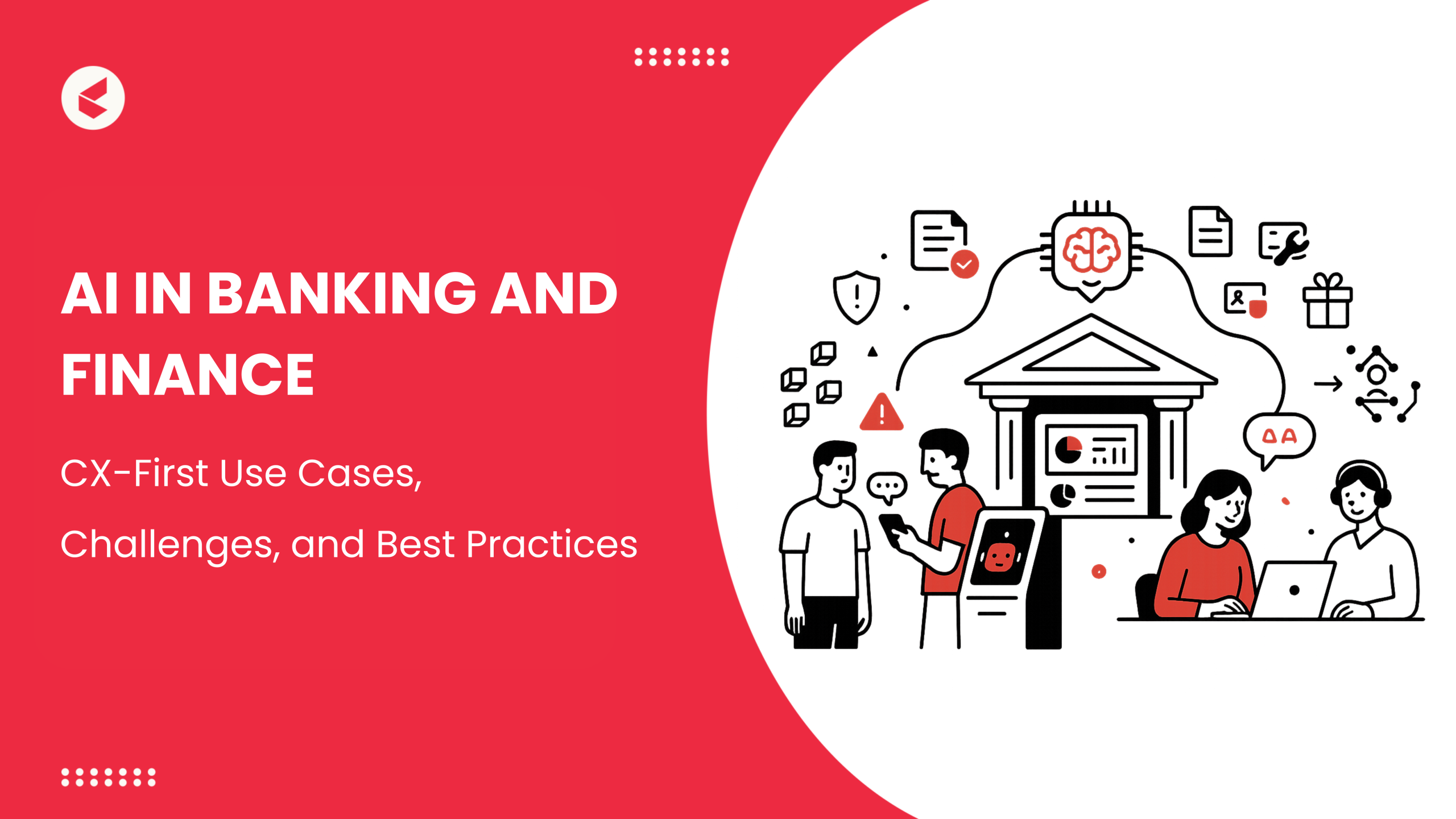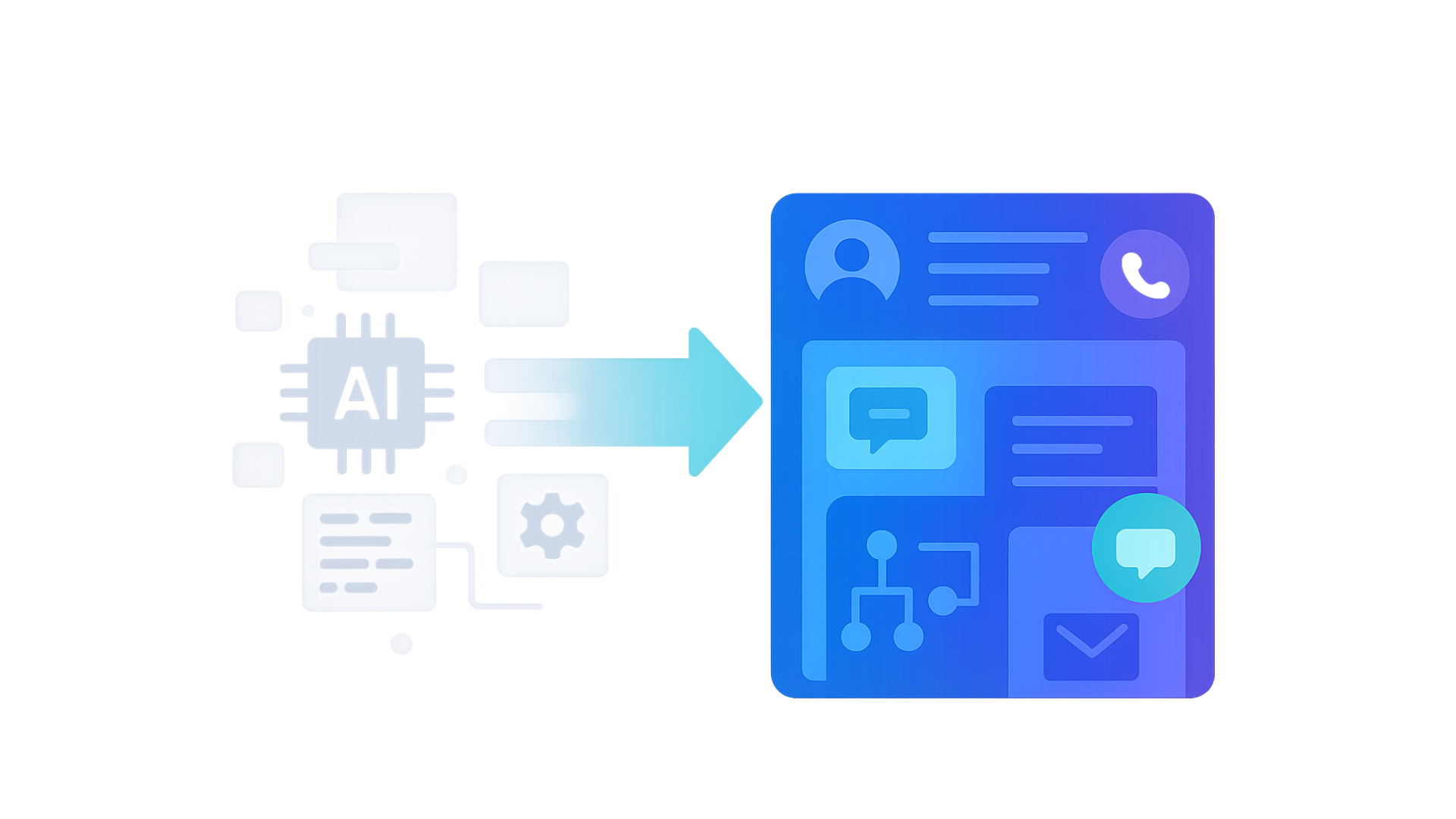Humans have always needed and chased convenience. From handwritten letters to instant chat bubbles, from hold music to AI assistants, we’ve constantly tried to make interactions faster, easier, and less painful. Customer support is no exception.
Intercom’s Fin AI jumped into the mix with clean UX, in-app messaging, and a single inbox that made ticketing systems feel ancient. It felt like the future, until the future caught up with us.
Fast forward to 2025, and CX leaders are now hitting walls with Fin AI. The platform’s automation feels clunky, reporting is limited, and it struggles under enterprise-scale pressure. Users are asking for more, smarter tools, better analytics, and support that doesn’t crack under load.
Meanwhile, many customers prioritize getting quick information more than anything else. And when your response time slips, so do your conversions. Which is why the hunt for Intercom Fin Alternatives is in full swing. The pressure to respond faster, personalize every interaction, and run leaner ops is no longer optional. You need smarter workflows, not heavier dashboards.
This blog rounds up 13 of the best options you should be looking at right now, before another customer slips through. Let’s get straight to it.
What Makes a Great Intercom Fin Alternative?
At first glance, Fin AI looks sleek and smart. But once teams scale or require serious automation, the cracks show. If you’re considering switching tools, look for the ones that actively fix the known gaps, especially the ones Intercom seems to ignore.
Here are 7 core areas where Fin has consistently fallen short, and what you should demand from its competitors:
1. Transparent resolution tracking with deep analytics
Choose AI tools that track real resolution rates—without inflating numbers—and give you full visibility into handoffs, follow-ups, and human interventions. Look for platforms with customizable analytics dashboards that let you drill into specific conversations, export raw data, and measure what actually drives outcomes, not just vanity metrics.
For example, one G2 reviewer noted: “Fin doesn’t achieve 65 % resolution rate like Intercom guarantees; it only achieves 50.7 %, and in truth… Fin still claims these as its resolutions… despite us having to pay a human to resolve them properly.”
2. Context-aware handoffs to humans
The good agent knows when to step back. For platforms, it is an opportunity for the user to easily request a human, with a response immediate enough so as not to bury it under menus or delays.
3. Built-in fail-safes for conversation loops
If your AI gets stuck saying the same thing twice, it’s not smart. Alternatives should include loop detection, fallback triggers, and behavior correction based on past failures.
4. Snappy support when things break (because they will)
Your CX platform should offer fast human support, especially during escalations or outages. Alternatives with SLA-backed support, not vague promises, are worth shortlisting.
5. Flexible pricing as you scale
A system that charges extra for every integration or automation isn’t built for growth.
6. Omnichannel support
Customers don’t live on one platform, your CX shouldn’t either. The best Fin AI Agent Competitors must offer seamless support across email, chat, social media, WhatsApp, and more without charging separately for each channel.
7. Training that fits your knowledge base
Some tools blame “your content” when responses go wrong. Look for agents that can train on your docs, FAQs, and tone, and that adapt to changing inputs instead of treating your setup as static.
8. Self-serve setup with deep configuration options
You shouldn’t need a dedicated engineer for every tweak. Strong alternatives offer easy onboarding and the flexibility to customize workflows, escalation paths, and fallback logic in minutes.
Intercom Fin Alternatives at a Glance: A Complete Breakdown
If you’re scanning for the right Intercom Fin replacement, make sure you carefully consider every little detail about the tool.
Here’s how all 13 stack up across key dimensions that matter:
| Platform | Key Features | Ideal For | Unique Strengths | Why It’s a Strong Fin Alternative |
| Kapture | Voice + chat automation, real-time alerts | Enterprise CX, India-heavy ops | Proactive workflows, native voice AI | Built for high-scale support, not just deflection |
| Help Scout | AI replies, Beacon self-serve, workflows | Startups and lean teams | Human-first AI inbox, flat pricing | More transparent and user-friendly than Fin |
| Zendesk | Agent assist, Answer Bot, omnichannel | Mid to large CX teams | Enterprise-grade workflows, deep integrations | Fin lacks depth and structured scaling |
| Freshdesk | Freddy AI, smart triage, multilingual | Product-led and B2B SaaS | Rich AI with low setup time | Delivers smarter automation with less overhead |
| LiveAgent | Call center + chatbot, omnichannel | SMBs with high ticket load | Built-in IVR, email, chat, voice | Fin doesn’t offer native voice support |
| Genesys CX | AI routing, journey orchestration | Enterprise with complex CX | Cross-channel experience automation | Way more orchestration vs. Fin’s static flows |
| Kustomer | AI + CRM, zero-code agent builder | Retail, fintech, fast DTC | Full customer timeline + AI | Fin can’t match CRM-level personalization |
| LivePerson | Conversational AI, commerce flows | High-volume retail or telco | 90% AI coverage, proactive messaging | Scales AI with real revenue impact |
| Gorgias | Ecom support + sales AI, Shopify native | DTC and ecommerce stores | Revenue-generating AI agent | Commerce-first, not support-only |
| IBM watsonx | No-code builder, voice + chat AI | Regulated enterprise teams | Policy-aware automation | Fin lacks enterprise governance + security |
| Zoho Desk | Zia AI, gen AI, low-code bots | Budget-aware support teams | AI included, no upsells | Affordable alternative with wide coverage |
| HelpCrunch | Multichannel inbox, popups, AI replies | SaaS, SMBs, ecommerce | All-in-one engagement suite | Full stack vs. Fin’s support-only angle |
| Salesloft + Drift | AI chat + sales orchestration | B2B sales and revenue teams | Drift bots + pipeline actions | Supports revenue conversion, not just replies |
Top 13 Intercom Fin Alternatives
Below are the strongest Intercom Fin Alternatives worth your attention in 2025:
1. Kapture
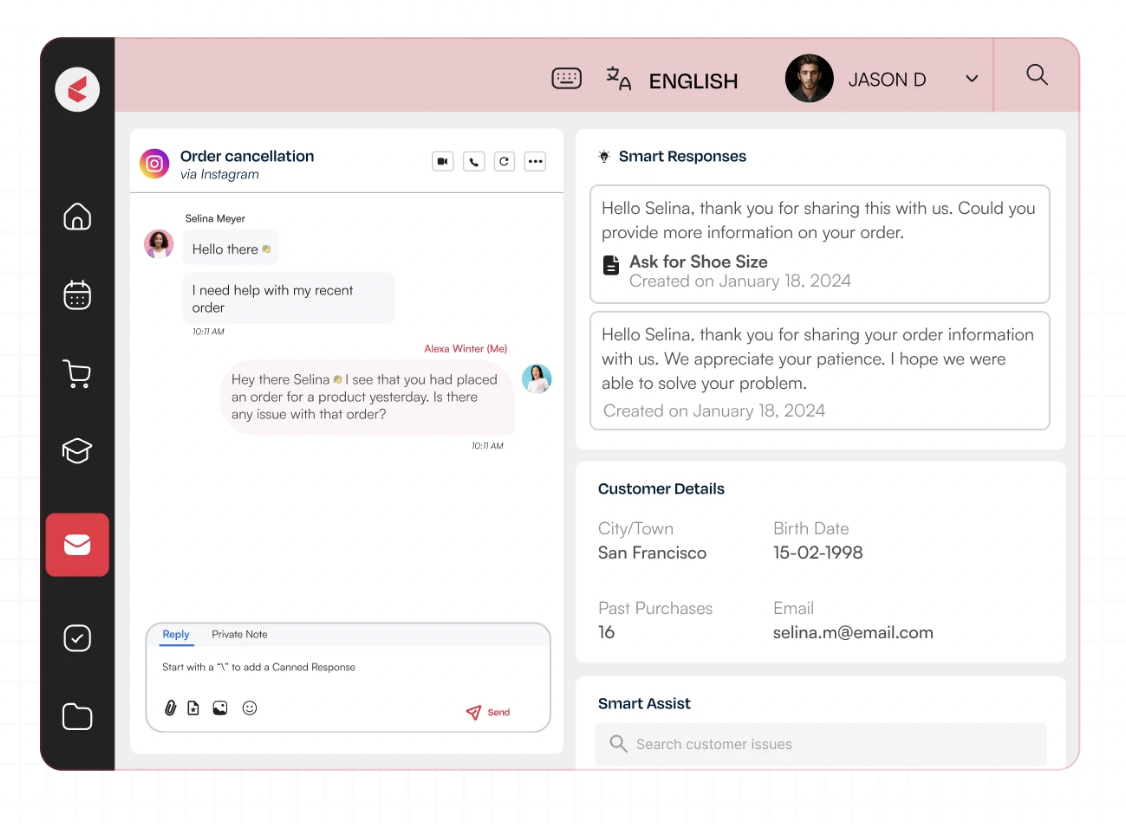
If you’re dealing with a high ticket volume and stretched support teams, Kapture brings something rare to the table: full-spectrum automation that doesn’t feel robotic. Built for Enterprises and optimized for scale, its Agentic AI platform handles both voice and non-voice queries, with real-time observability and proactive engagement baked in.
Key Features
- Voice AI Agents: Launch inbound and outbound voice bots in under 10 minutes with real-time fallbacks.
- Unified Workflow Automation: Automate resolutions across WhatsApp, email, chat, and social—no manual stitching.
- Single View Analytics: Track sentiment, quality, and resolution metrics in one dashboard built for support leads.
Why It Stands Out
- With support for hybrid voice and chat flow, all in the box. Requires no third-party plugins or connectors. It audits 100% of conversations without any random QA sampling on all channels.
- Includes proactive workflows for follow-ups, reminders, and recovery flows that reduce drop-offs before they happen
| 🔑 Best Suited For: Large support teams in fast-scaling industries needing voice + chat automation. |
User Ratings
2. Help Scout
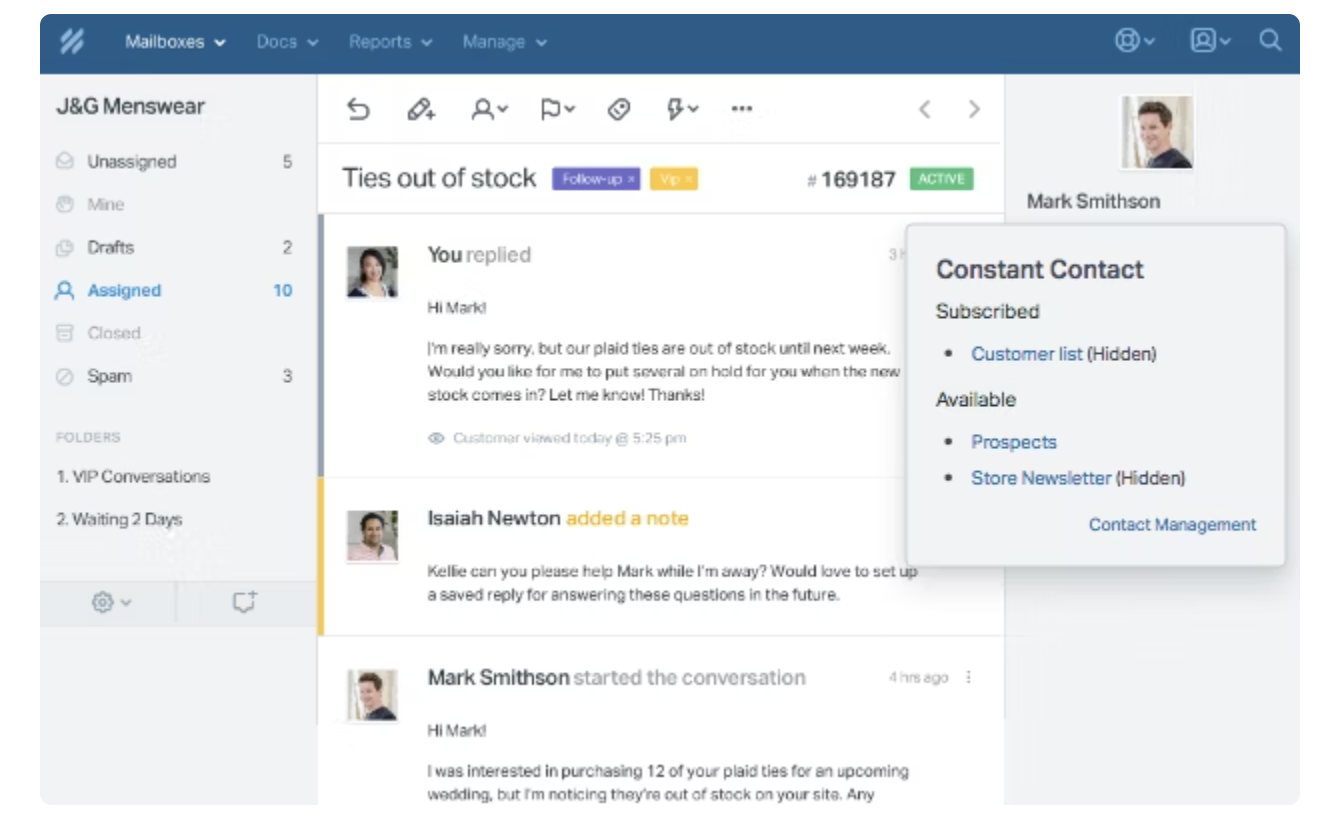
Help Scout is what happens when support software gets out of your way and just works. It’s built to feel like a shared inbox, familiar, fast, and designed for real conversations.
Key Features
- AI Drafts: Instantly generate, edit, and translate personalized replies using built-in AI.
- Workflow Automation: Automate tagging, assignments, snoozes, and follow-ups without code.
- Beacon Help Widget: Offers in-chat, context-aware answers backed by your knowledge base and AI.
Why It Stands Out
- AI tools are included on all plans—no upsells or usage-based restrictions.
- Built to feel like Gmail, but optimized for team collaboration and speed.
- Unlimited users on flat pricing make it startup- and scale-friendly.
| 🔑 Best Suited For: Support teams that want a human-led inbox with powerful built-in AI, minus the noise. |
User Ratings
3. Zendesk
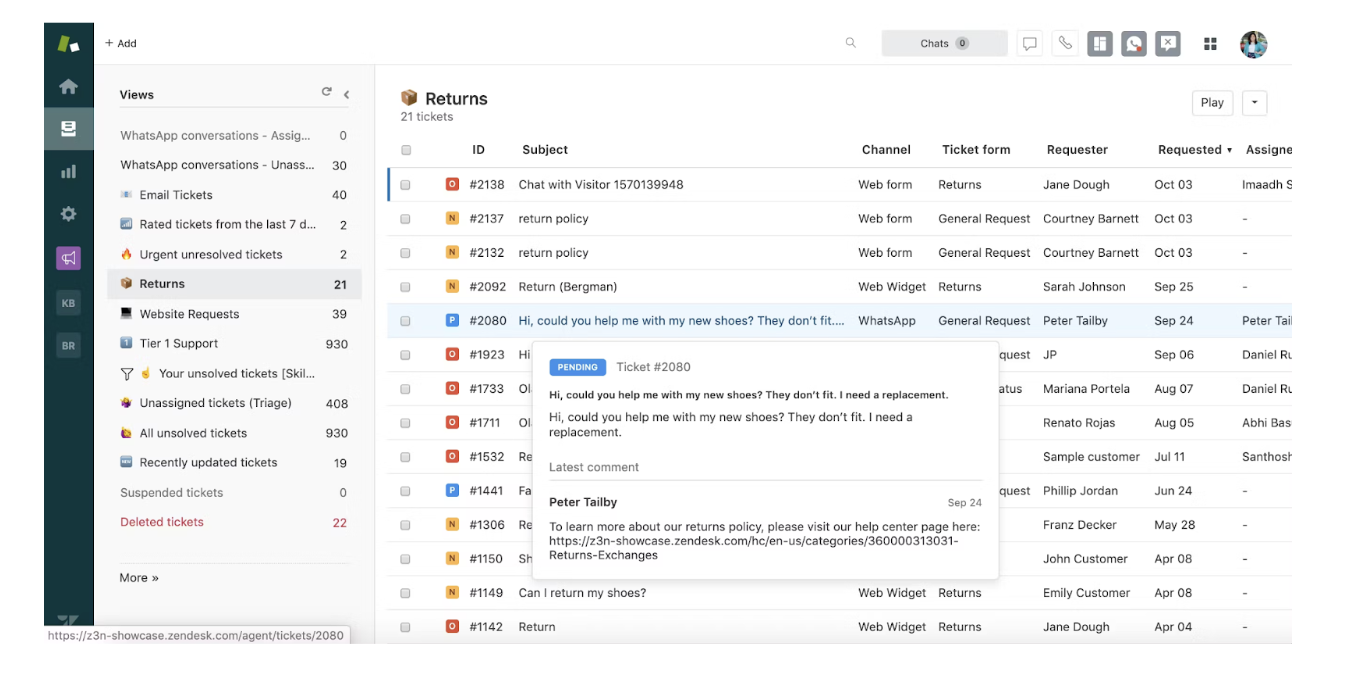
Zendesk doesn’t need much of an introduction. It’s one of the most established platforms in the customer support space, designed for companies that require significant scale, structured automation, and AI that works out of the box. If you want a system that’s built to last and grow with your business, Zendesk holds up.
Key Features
- Omnichannel Suite: Manage email, chat, voice, and social tickets from one dashboard.
- AI Agent Assist: Auto-suggests replies, tags intent, and summarizes tickets in real time.
- Custom Dashboards: Monitor KPIs across teams with drag-and-drop analytics and exports.
Why It Stands Out
- It offers built-in routing, SLAs, and compliance tools which makes it perfect for enterprises.
- Native support for phone, email, chat, and social—no add-ons or patchwork tools required.
| 🔑 Best Suited For: Mid to large teams managing high ticket volumes with complex workflows and multiple support channels. |
User Ratings
Interesting Read – 13 Must-Know Zendesk Alternatives for 2024
4. Freshdesk
Freshdesk, built by Freshworks, is made for teams that want advanced AI without the fuss. Its Freddy AI stack gives you automated resolutions, contextual triage, and multi-language support in a system that’s fast to deploy and easy to manage. Whether you’re running a lean CX team or scaling fast, Freshdesk doesn’t slow you down.
Key Features
- Freddy AI: Resolves up to 86% of repetitive queries instantly with contextual, human-like responses.
- Agent Copilot: Suggests replies, flags tone shifts, and summarizes long conversations.
- Auto-Triage: Detects query intent and updates ticket properties without manual input.
Why It Stands Out
- Full-stack automation with multilingual AI support makes it one of the most practical Fin AI Alternatives for growing teams.
- The built-in sentiment detection features help prioritize complex issues before they escalate.
| 🔑 Best Suited For: Support teams that want powerful AI with a clean interface and flexible automation at scale. |
User Ratings
5. LiveAgent
LiveAgent is built for CX teams that need a no-fuss, all-in-one help desk, without waiting weeks to set it up. It offers an omnichannel suite with over 130 ticketing features, a built-in call center, AI-powered chat, and strong social media integrations. The value prop is simple: reduce costs, simplify support, and do it all fast.
Key Features
- AI Chatbot: Handles common queries like order tracking and returns, freeing up agent time.
- Built-In Call Center: Offers IVR, call routing, and recording—no plugins required.
- Unified Inbox: Tracks email, chat, phone, and socials in one view for faster resolution.
Why It Stands Out
- Among the fastest-to-deploy Fin AI Alternatives with omnichannel capabilities out of the box.
- Native voice support and call handling—rare among Intercom Fin Alternatives in its tier.
| 🔑Best Suited For: Support teams looking for a fast, budget-friendly, and fully omnichannel customer service platform. |
User Ratings
6. Genesys Cloud CX
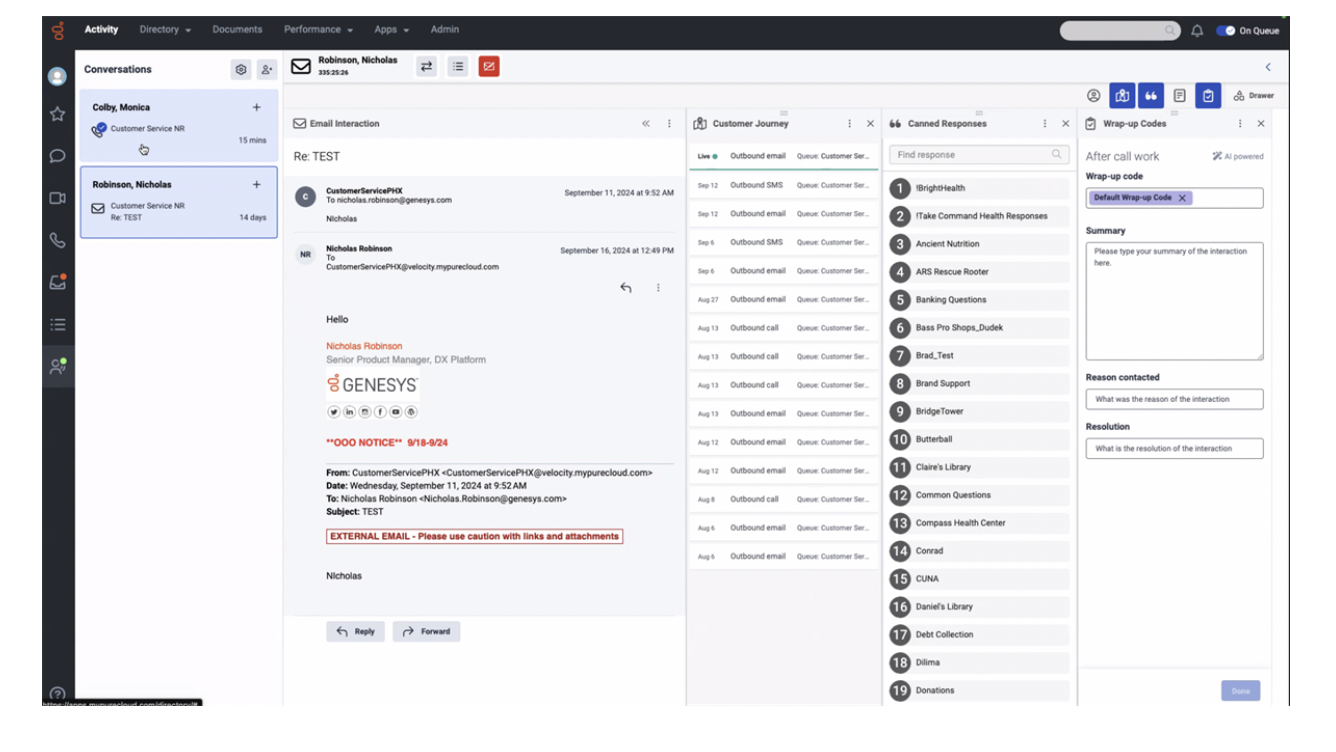
Genesys Cloud CX is a full-blown AI-powered experience orchestration platform. With voice, digital, workforce management, and journey analytics packed into one platform, it’s designed for companies that need to connect the dots across large-scale operations. This is enterprise-grade CX automation that goes far beyond just answering tickets.
Key Features
- Omnichannel Orchestration: Connects voice, chat, email, and social into a single, seamless dashboard.
- Predictive AI Routing: Uses intent and sentiment to route tickets to the right agent at the right time.
- Customer Journey Mapping: Visualize and optimize customer flows across every channel.
Why It Stands Out
- One of the most enterprise-ready Fin AI Agent Competitors with native workforce management and AI-powered decision-making.
- Built for scale and governance—ideal for complex, multi-department orgs with layered workflows.
| 🔑 Best Suited For: Large enterprise teams that need end-to-end experience orchestration across customer and employee journeys. |
User Ratings
7. Kustomer
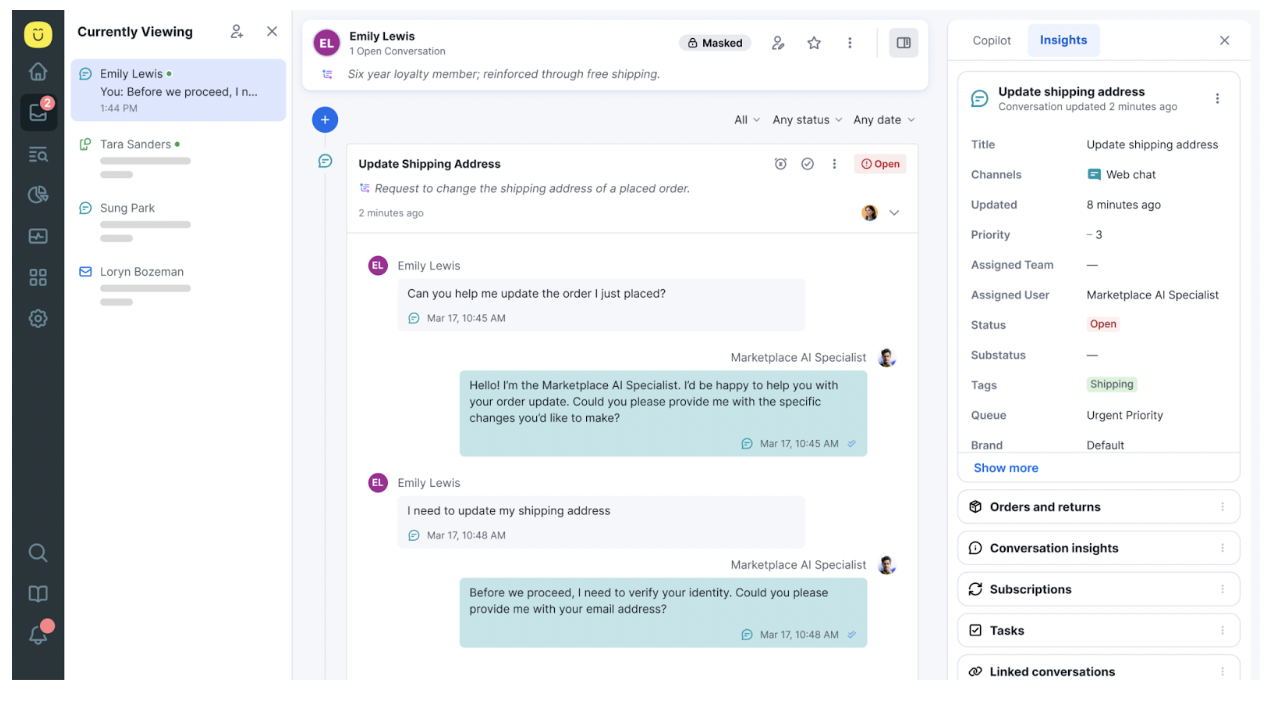
Kustomer combines CRM, ticketing, and AI into one platform built for flexibility and control. Unlike tools that bolt on automation later, Kustomer was built from the ground up to make AI work with your data, not around it. With its AI Agent Studio, you can create customized AI agents for every use case, no coding required.
Key Features
- AI Agent Studio: Build and deploy no-code AI agents tailored to your workflows.
- Omnichannel Automation: Handle voice, email, SMS, chat, and social without needing third-party tools.
- CRM Built-In: Full customer timeline with history, sentiment, and intent in one interface.
Why It Stands Out
- Combines CRM and automation in a single platform, making it more adaptive than most Fin AI Agent Competitors.
- Let’s you create use-case-specific bots without dev dependency—ideal for fast-moving CX teams.
| 🔑 Best Suited For: CX teams that want AI, CRM, and omnichannel service in one platform, with zero-code configurability. |
User Ratings
8. LivePerson
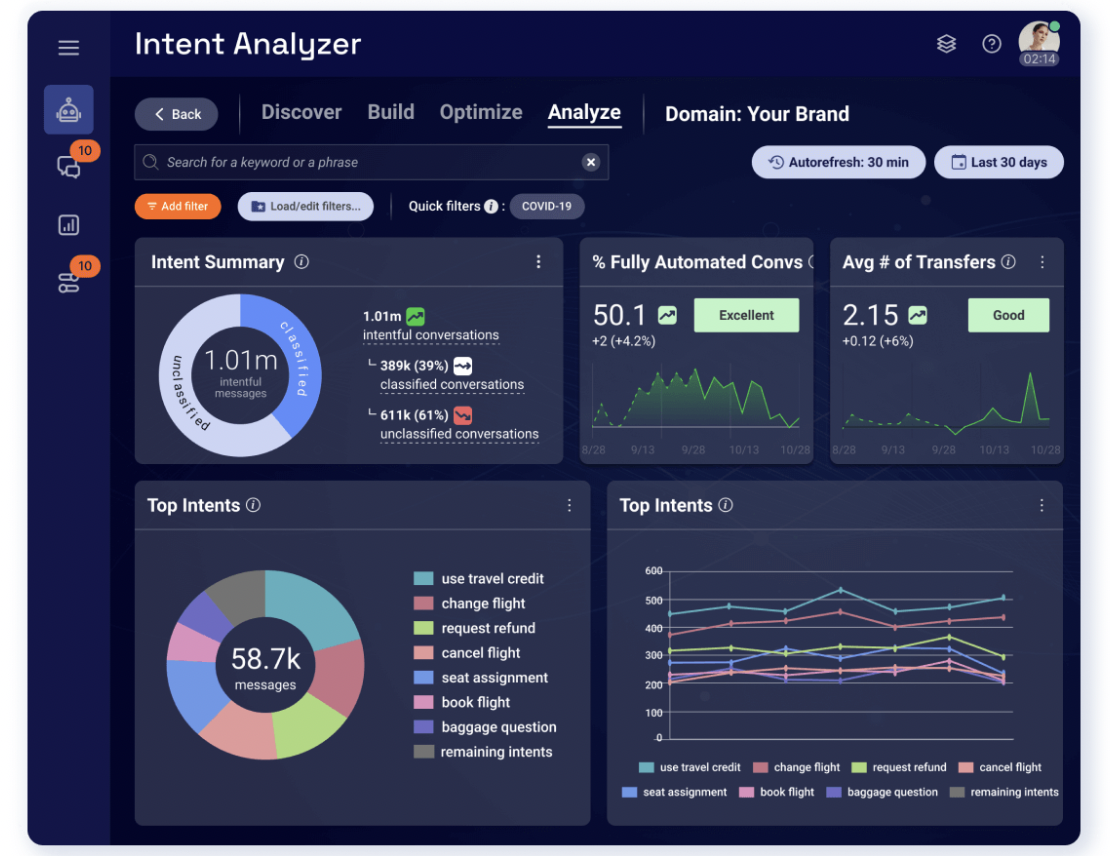
LivePerson is a platform built to help businesses go beyond simple ticket resolution and enable intelligent conversations throughout the customer journey. Using conversational AI, it automates up to 90% of interactions, triples agent capacity, and delivers measurable ROI without requiring additional tech layers.
Key Features
- Conversational AI: Automates up to 90% of interactions across messaging and voice.
- Unified Analytics: Tracks, analyzes, and optimizes conversations from all touchpoints.
- Agent Assist Tools: Context-aware prompts and summaries boost agent output.
Why It Stands Out
- It makes it one of the few Intercom Fin Alternatives proven to handle enterprise-level complexity.
- Gives you the option to plug in your own LLMs, which most Fin AI Alternatives can’t support natively.
| 🔑 Best Suited For: Enterprise CX teams looking to automate intelligently across voice and messaging, without rebuilding from scratch. |
User Ratings
9. Gorgias
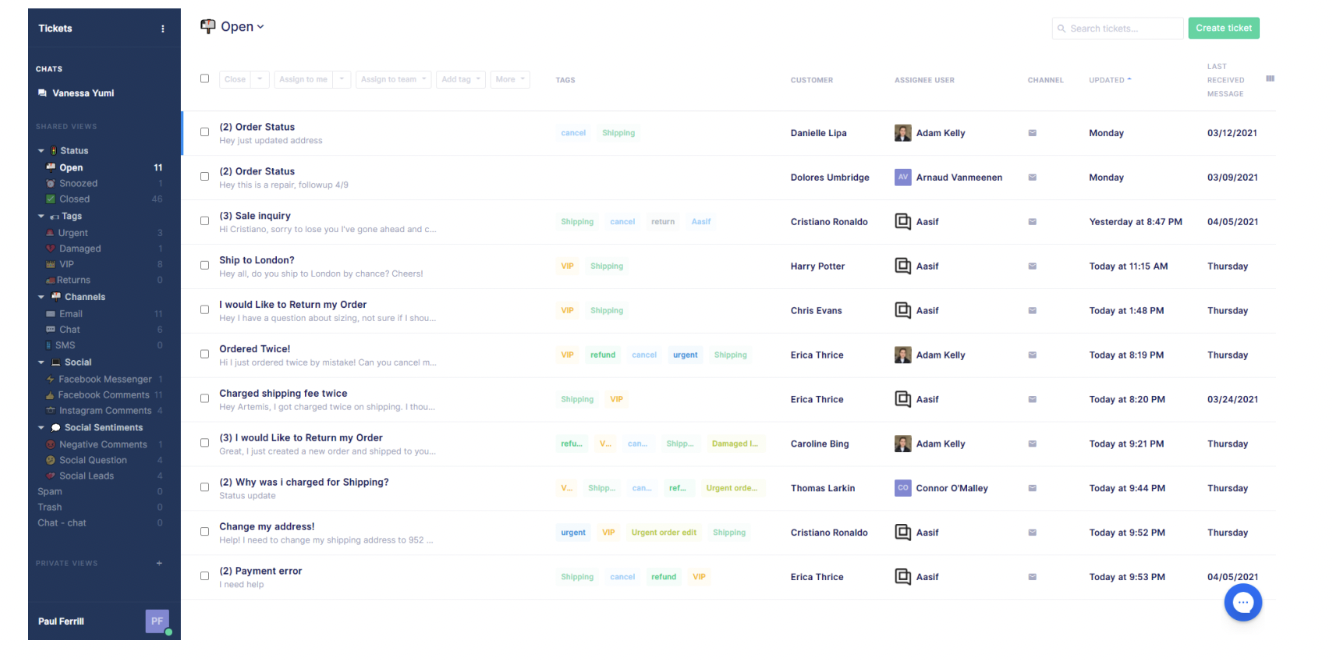
Gorgias is built for ecommerce, specifically for brands that want to turn support into a sales engine. Its AI Agent handles both support and sales queries, offering personalized product recommendations and real-time campaign responses. With deep Shopify integration and automation that covers up to 60% of tickets, Gorgias doesn’t just answer questions; it helps close carts.
Key Features
- AI Agent for Sales + Support: Resolve common inquiries while upselling with tailored product suggestions.
- Shopify Native Tools: Edit orders, check inventory, and launch promos directly from the helpdesk.
- Proactive Campaigns:Trigger discount chats, recover abandoned carts, and reduce bounce in real time.
Why It Stands Out
- One of the few Fin AI Alternatives tailored specifically for ecommerce.
- Blends support automation with conversion-optimized flows—most Fin AI Agent Competitors don’t touch revenue.
| 🔑 Best Suited For: Ecommerce brands looking to automate support and convert browsers into buyers through AI-powered conversations. |
User Ratings
Also Read – 9 Best Gorgias Alternatives for CX-Driven Brands in 2025
10. IBM Watsonx Customer Care Agents
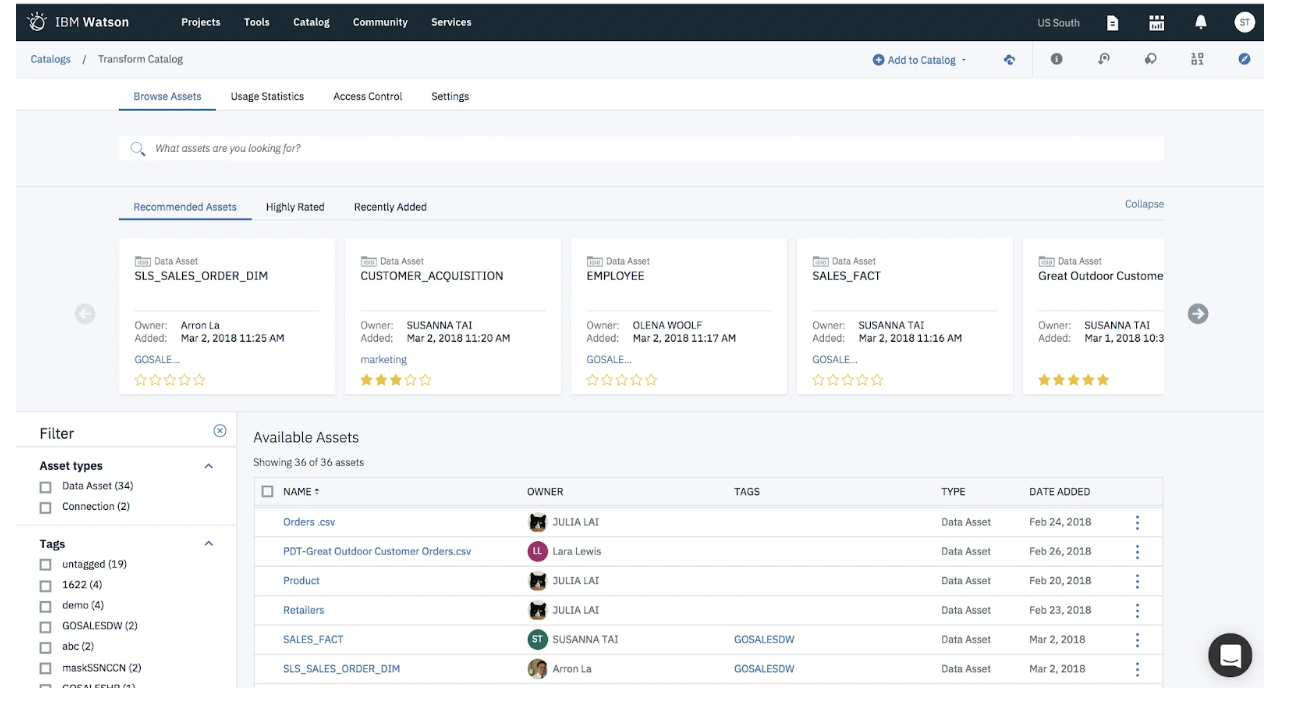
IBM’s watsonx suite includes watsonx Assistant, a rebranded and more powerful successor to Watson Assistant, and watsonx Customer Care Agents—prebuilt AI agents available via watsonx Orchestrate designed specifically for contact centers to handle service requests autonomously.
Key Features
- No-Code AI Agent Builder: Launch intelligent agents tailored to policies, workflows, and knowledge bases.
- Real-Time Assistance: Equip agents with context-aware suggestions and relevant customer insights.
- Cross-Channel Coverage: Deploy across voice, chat, and digital channels with unified orchestration.
Why It Stands Out
- Prioritizes compliance and data control—ideal for regulated industries where most Fin AI Agent Competitors fall short.
- Structured automation that mirrors internal policies and workflows, not just generic intent models.
| 🔑 Best Suited For: Enterprises looking to build AI-powered, policy-aligned customer service workflows, without depending on engineering teams. |
User Ratings
11. Zoho Desk
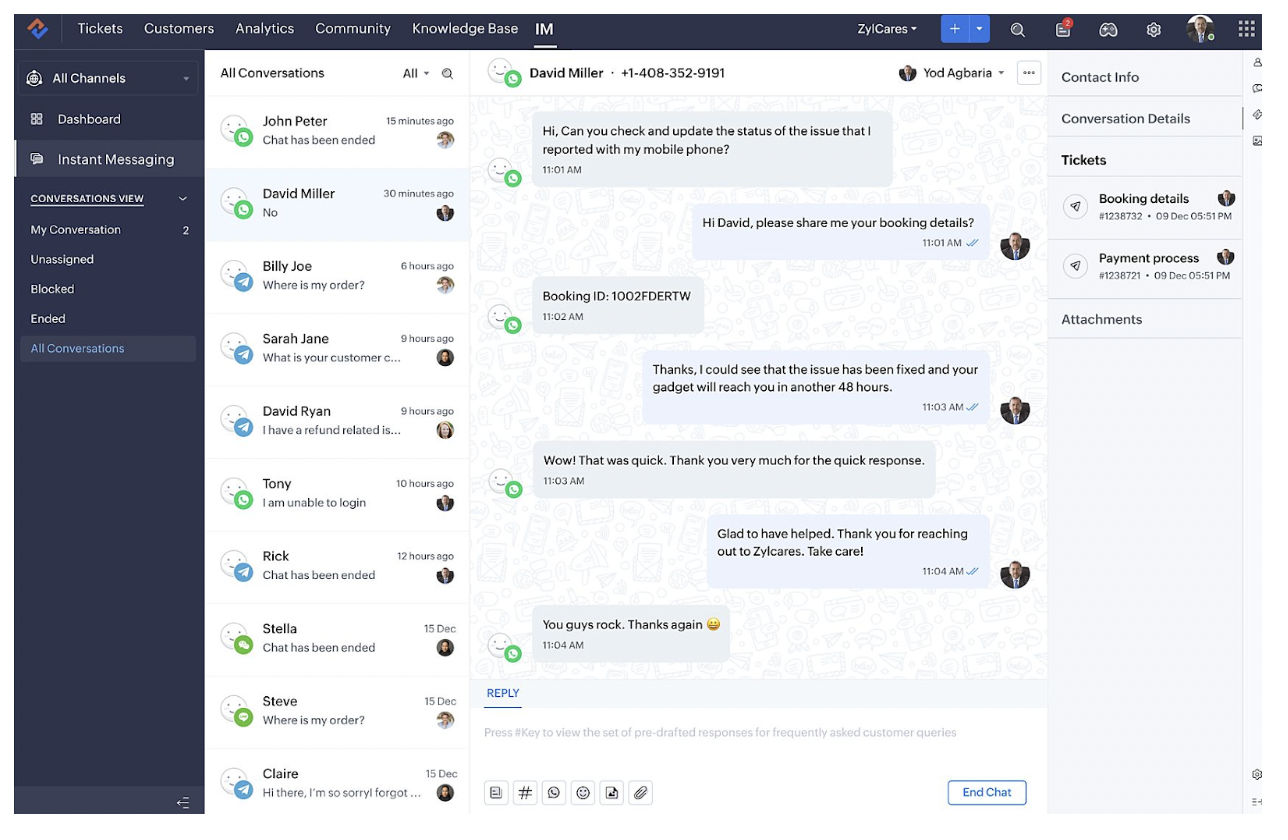
The Zoho Desk connects AI and customer service through its inbuilt virtual assistant called Zia. Instead of marketing AI as a separate and expensive product, Zoho has chosen to make it a part of the core platform, thereby giving small businesses the powerful tools of automated ticket analysis and reply generation. Zia operates cross-channel, supports the agent on the go, and aligns with real-life support workflows without adding any added complexities.
Key Features
- Answer Bot:Use your knowledge base to instantly resolve customer queries across chat and web.
- Generative AI for Agents: Summarize tickets, auto-draft replies, rewrite tone, and suggest improvements.
- Sentiment Detection & Routing: Prioritize and escalate based on intent, urgency, and tone.
Why It Stands Out
- Native AI without usage caps makes it a high-value Intercom Fin Alternative for smaller teams.
- Zia adapts to ticket trends over time, unlike most static Fin AI Agent Competitors.
| 🔑 Best Suited For: Support teams that need strong AI features, easy onboarding, and full value without hidden costs. |
User Ratings
12. HelpCrunch
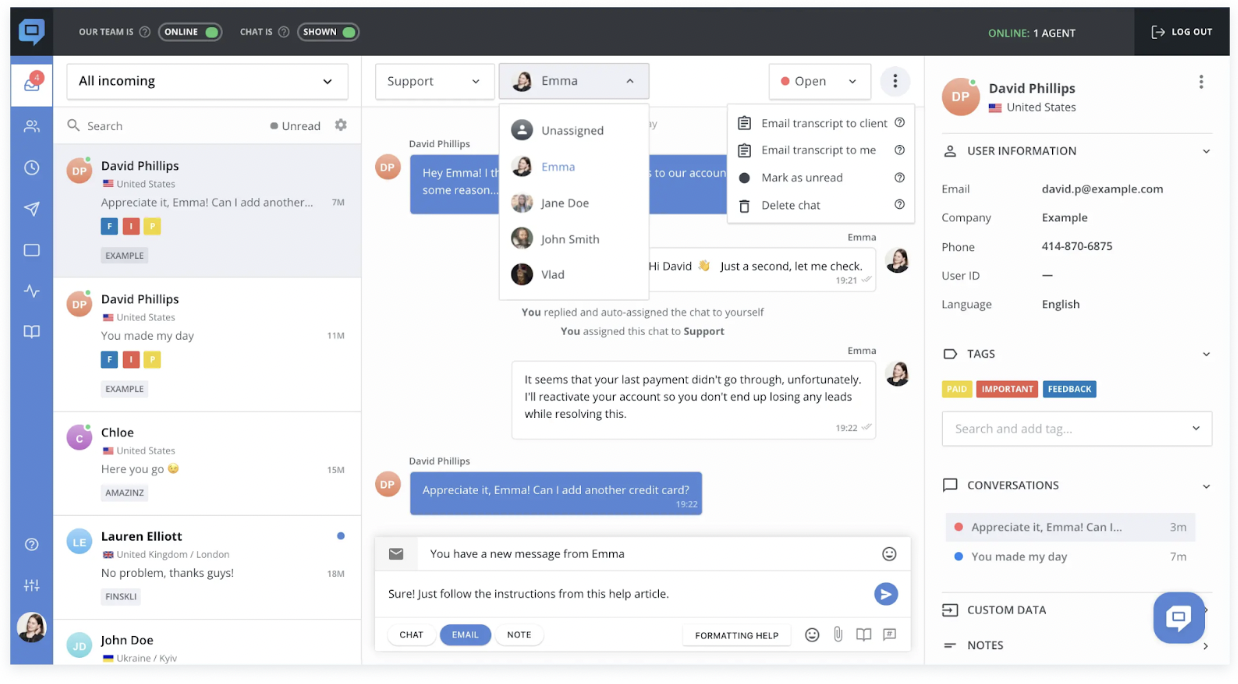
HelpCrunch is an agile and AI-enhanced customer support platform for companies that want to move fast without compromising quality. From multichannel support to knowledge bases, email marketing, and in-chat promotions, everything resides in one clean, customizable workspace. It’s made to help organizations reduce tool sprawl and increase automation and engagement.
Key Features
- AI Editor: Generate polished replies and help docs instantly from short inputs.
- Multichannel Inbox: Handle chat, email, WhatsApp, Instagram, and more in a single view.
- Self-Service Knowledge Base: Build a searchable, branded help center with built-in SEO tools.
- Auto Messages & Popups: Trigger smart campaigns and lead-gen flows based on user behavior.
Why It Stands Out
- AI is lightweight but effective—agents get faster, and customer engagement doesn’t feel robotic.
- Fastest setup time on this list with built-in lead gen tools, most Fin AI Agent Competitors lack.
| 🔑 Best Suited For: SaaS and ecommerce teams looking for an affordable, all-in-one support + engagement platform with built-in AI. |
User Ratings
13. Salesloft + Drift
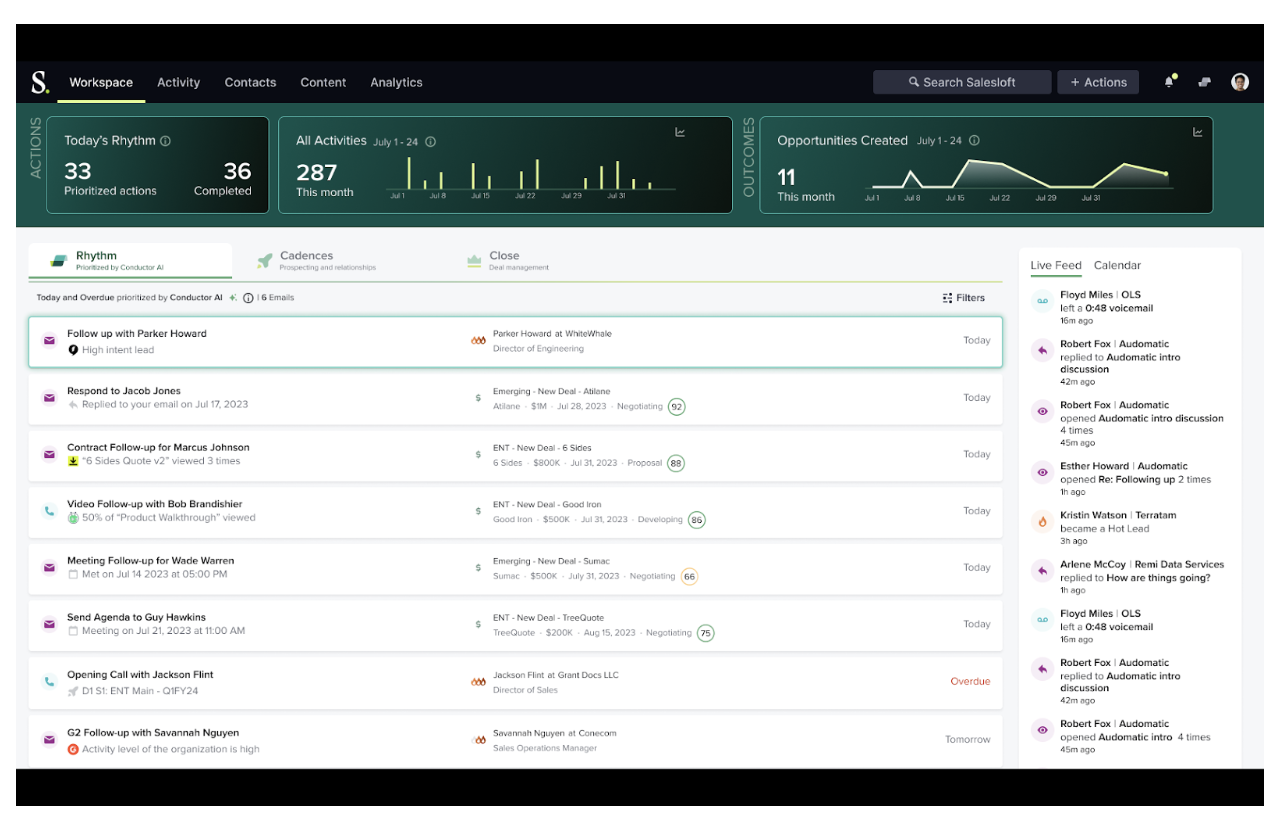
Salesloft has turned its revenue orchestration platform into an AI-driven machine. At the center of its push is Drift, a conversational AI engine that doesn’t just chat, it books meetings, qualifies leads, routes buyers to reps, and feeds the rest into a CRM-backed sales workflow. It’s not just about support. It’s about converting traffic into pipeline with real-time data, intent scoring, and integrated sales action. According to Drift, companies using its AI chat saw up to 50% more qualified pipeline within the first six months of deployment.
Key Features
- Drift Chat Agent:Smart AI that talks like a human and knows when to escalate to a live rep.
- Lead Qualification + Routing: High-intent visitors are ID’d, scored, and routed automatically.
- Deep Analytics + Attribution: Know exactly which conversations generate revenue.
Why It Stands Out
- It is built for revenue teams, not just support, making it a rare Fin AI Alternative optimized for top-line growth.
- AI flows are tightly integrated with sales ops, not siloed like most Fin AI Agent Competitors.
- Targets high-intent visitors with personalized chat that leads to actual closed deals—not just deflections.
| 🔑 Best Suited For: Mid-market to enterprise sales teams who want AI agents that don’t just chat, they close. |
User Ratings
How to Choose the Right One for Your Business
Picking the right Fin alternative isn’t just about AI. It’s about finding a system that works under pressure, adapts to your workflows, and helps, not hinders, your team. Here is a clear checklist to help you out:
- Voice + Chat AI Agent Support: If you get support requests via both calls and chat, make sure the platform handles both natively, without routing hacks or third-party plugins.
- Self-Service Built-In (Not a Paid Add-On):You shouldn’t have to pay extra for a help center or AI-generated FAQs.
- Workflow Automation Across Channels: Check if automations work across WhatsApp, email, web chat, and socials, not just within the app. One channel gap = broken experience.
- Smart Handoff Triggers: Your AI should know when it’s in over its head. Look for configurable handoff logic: based on sentiment, repetition, or time spent.
- AI That Learns From Your Content: Some bots just surface pre-written answers. Better platforms adapt and learn from your knowledge base, recent tickets, and tone of voice.
- Real-Time Analytics and Sentiment Tracking: You should know when things go wrong, not find out in next month’s report. Look for dashboards that surface intent, tone, drop-off rates, and agent assist metrics.
- Customization Without Engineers: Whether it’s fallback flows, ticket rules, or escalation logic, you should be able to configure it yourself. Bonus if it includes low-code builders.
- SLA-Backed Support: If something breaks, you need human help fast. Shortlist platforms that offer SLA-backed support or live rep access for enterprise accounts.
- CRM, Ecomm, and API Integrations: A good CX stack plays nicely with your tools. Ensure you can plug in Salesforce, Shopify, internal databases, or whatever powers your ops.
- Transparent Pricing, No AI Metering: Avoid platforms that meter AI usage or charge per resolution. Costs should be predictable, even if volume spikes.
Implementation and Switch Tips
Switching from Fin AI isn’t just a tool change — it’s an opportunity to redesign your CX workflows
Tip 1: Avoid migrating outdated workflows blindly
Don’t migrate every workflow or automation from Fin blindly. If it didn’t serve you there, it won’t magically work elsewhere. Use the switch as a cleanup, cut dead rules, kill unused tags, and audit what solves problems.
Tip 2: Rebuild for outcome, not process
Most teams design their support flows around how agents work. Flip that. Design them around customer goals. Fast refund? Escalation within 60 seconds? Use your new platform’s AI and automation not to mimic old flows, but to shorten time-to-resolution.
Tip 3: Let your agents break things
Before you lock everything in, give your frontline agents sandbox access. Let them test edge cases, hit dead ends, and flag broken intents. They’ll find what QA and managers miss, because they live in these systems every day.
Get Faster, Smarter, Scalable CX With Kapture
Customer support in 2025 is about relevance, precision, and scale. Intercom Fin was a strong step forward, but many teams are now looking for tools that handle higher volume, multilingual operations, and deeper automation without breaking under pressure.
Among the top alternatives, Kapture CX stands out as an enterprise-grade option with voice + chat automation and real-time observability. If you’re evaluating platforms that can grow with your business, it’s worth adding to your shortlist.
Book a demo with Kapture and see it live!
FAQs
Fin AI is Intercom’s chatbot that handles basic customer queries using generative AI, focused mostly on self-service inside Intercom’s chat interface.
Intercom’s Fin AI runs on OpenAI’s GPT-4, layered with Intercom’s own customer service training and interface logic.
It completely depends on your use case. There’s a tool for every industry and its needs. For example, Kapture’s AI tool excels at combining automation that adjusts to intricate workflows with real-time involvement.
Intercom has multiple alternative solutions that are now available widely in the market. Some of them include, Kapture CX, Zendesk, Freshdesk, and more.
Tools like Zoho Desk, HelpCrunch, or Help Scout are popular among small teams because they’re affordable, easy to set up, and include AI features without extra upsell costs. They handle multi-channel support out of the box, making them practical Fin AI alternatives for lean CX teams.
AI makes customer experience platforms faster, smarter, and more proactive. It automates repetitive queries, routes tickets to the right agents, summarizes conversations, and even detects sentiment in real time. This reduces response times, prevents burnout for support teams, and delivers more personalized service—whether customers reach you on chat, voice, email, or social channels.
